Identification of Priority Conservation Areas for Protected Rivers Based on Ecosystem Integrity and Authenticity: A Case Study of the Qingzhu River, Southwest China
Abstract
1. Introduction
2. Materials and Methods
2.1. Case Study
2.2. Research Data
2.3. Ecosystem Integrity and Authenticity
2.4. Analysis Framework
- Step 1.
- Determination of the spatial extent of PAR
- Step 2.
- Selection of constitutive elements for integrity and authenticity of a river ecosystem
- Step 3.
- Indicator selection and calculation
- (1)
- Irreplaceability
- (2)
- Tree cover
- (3)
- Wilderness index
- Step 4.
- Weight determination and layer overlay
3. Results
3.1. Spatial Patterns of CPV
3.2. The Spatial Pattern of PCAR
4. Discussion
4.1. Theoretical Validation of CPV
- (1)
- Comparison of the distribution of areas with high value for protection identified by SIR’ and SCPV
- (2)
- The rationality of CPV
4.2. The Validation of CPV at a Practical Level
5. Conclusions and Outlook
Author Contributions
Funding
Informed Consent Statement
Data Availability Statement
Acknowledgments
Conflicts of Interest
Appendix A
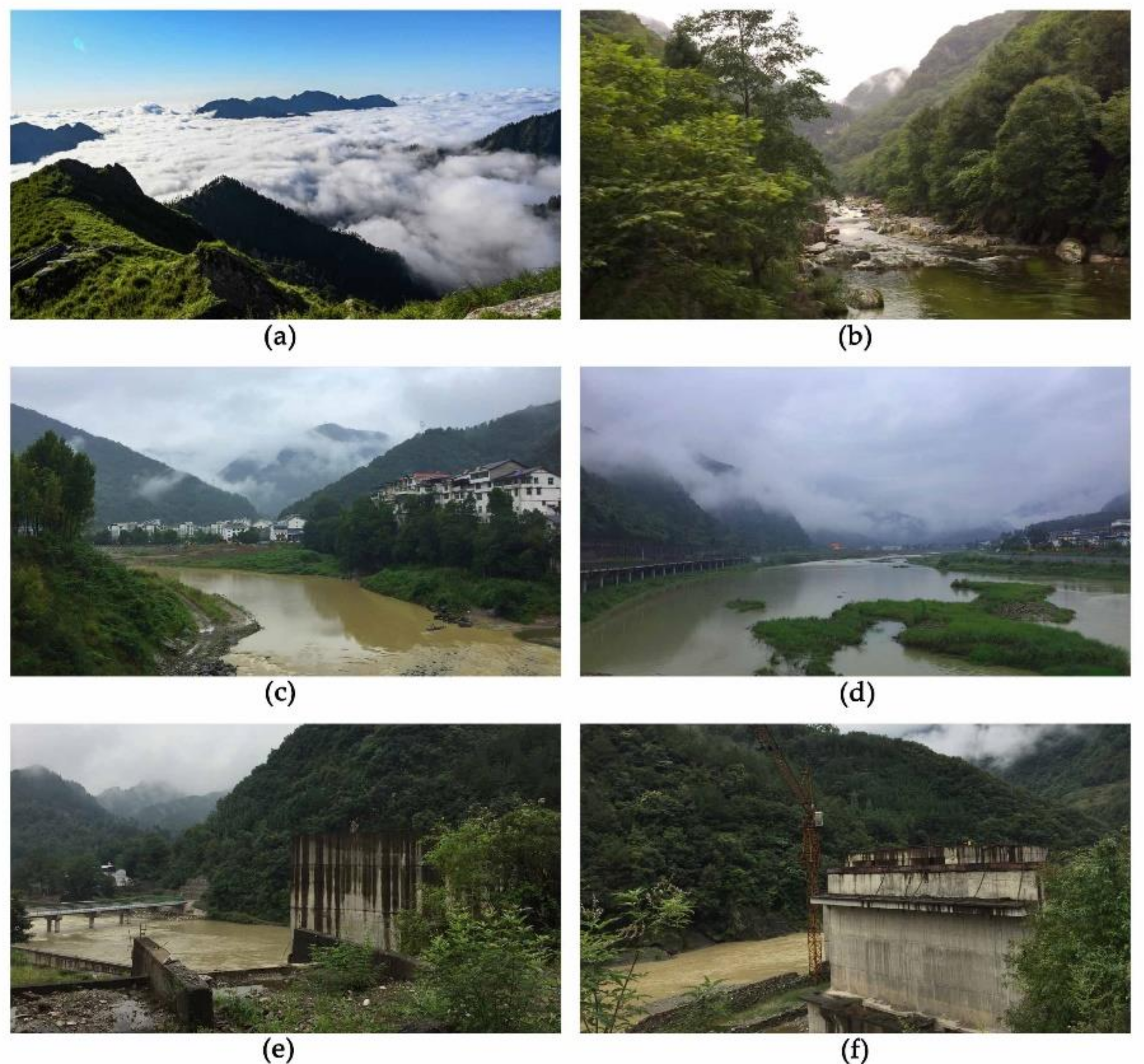
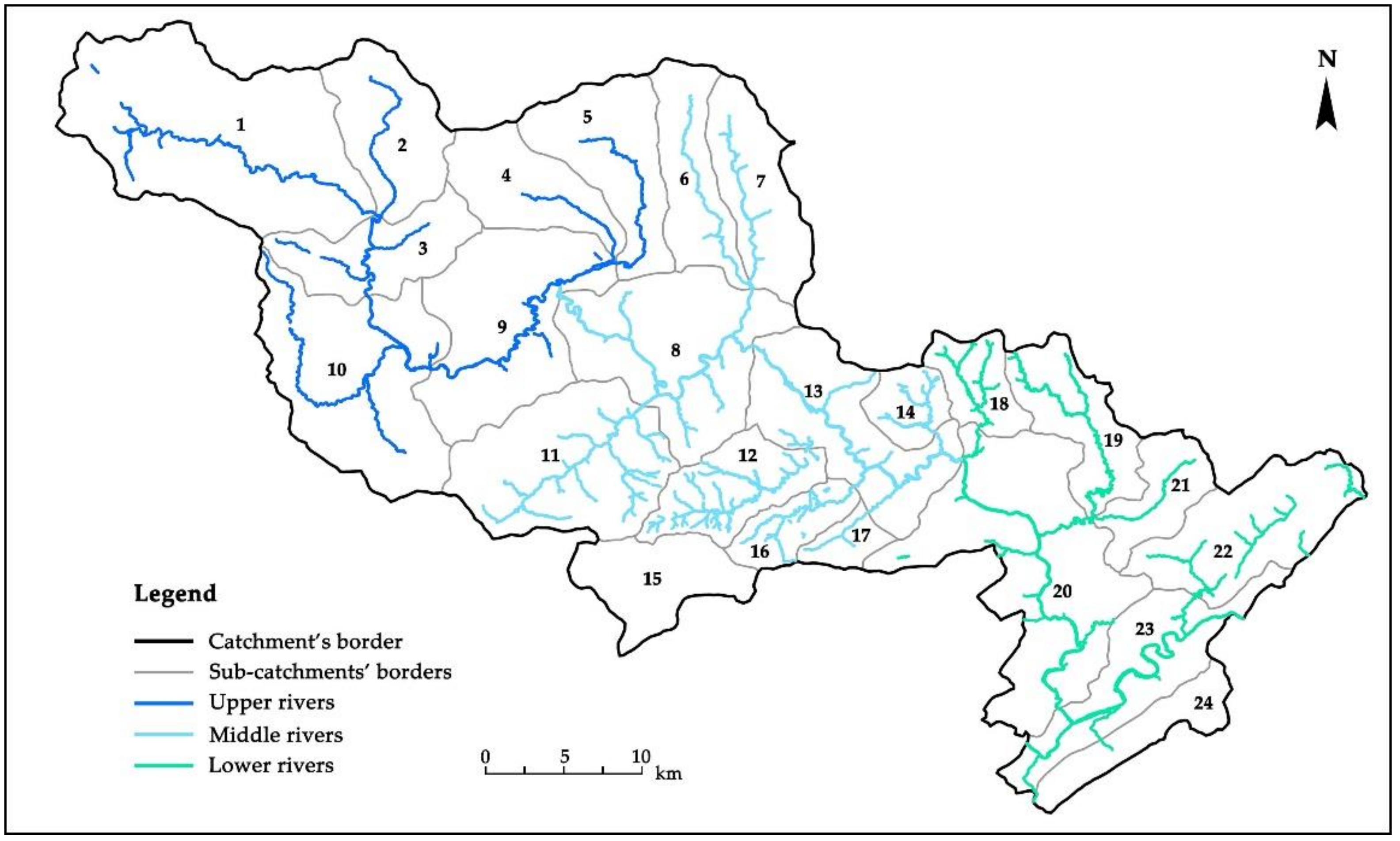
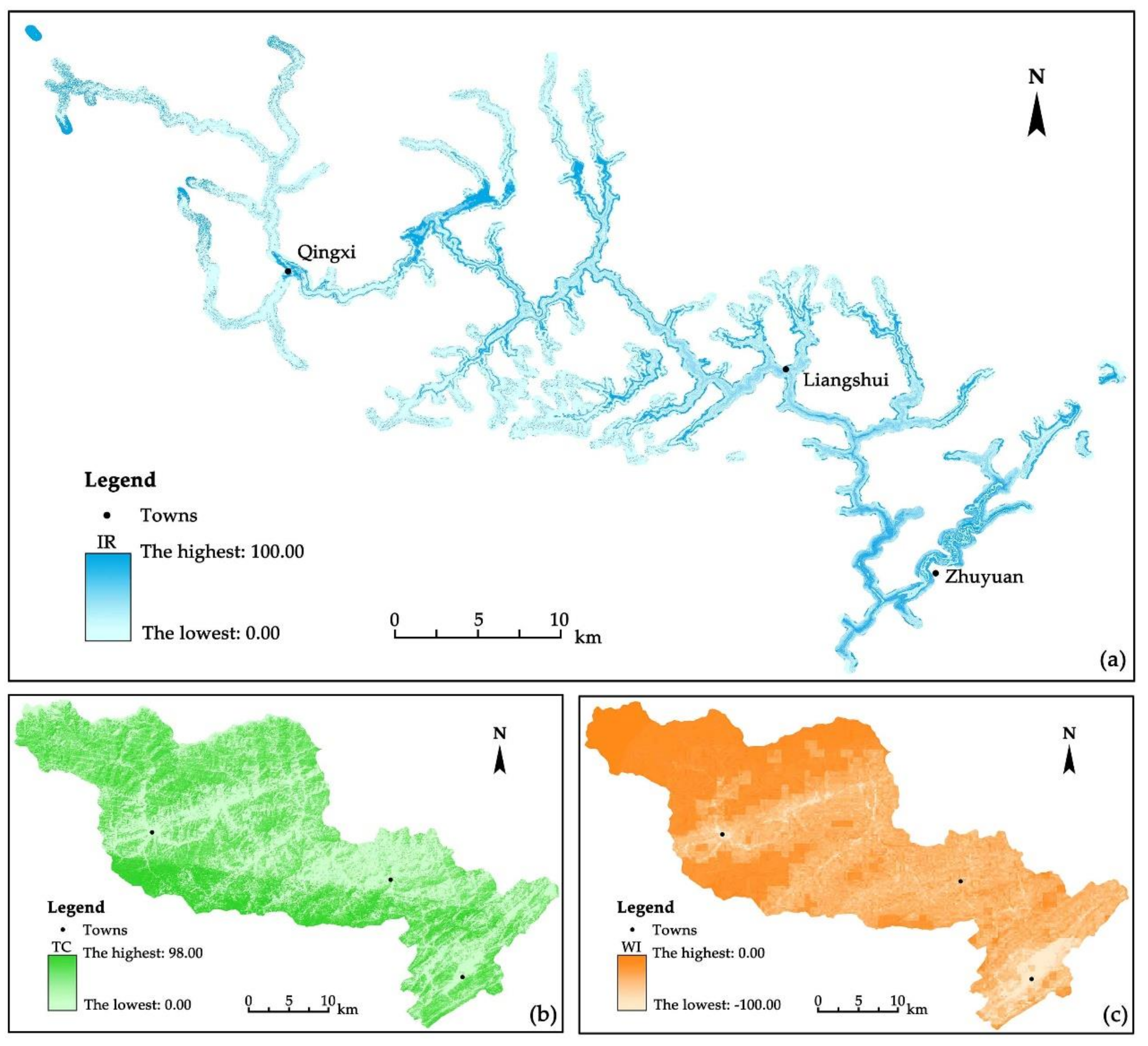
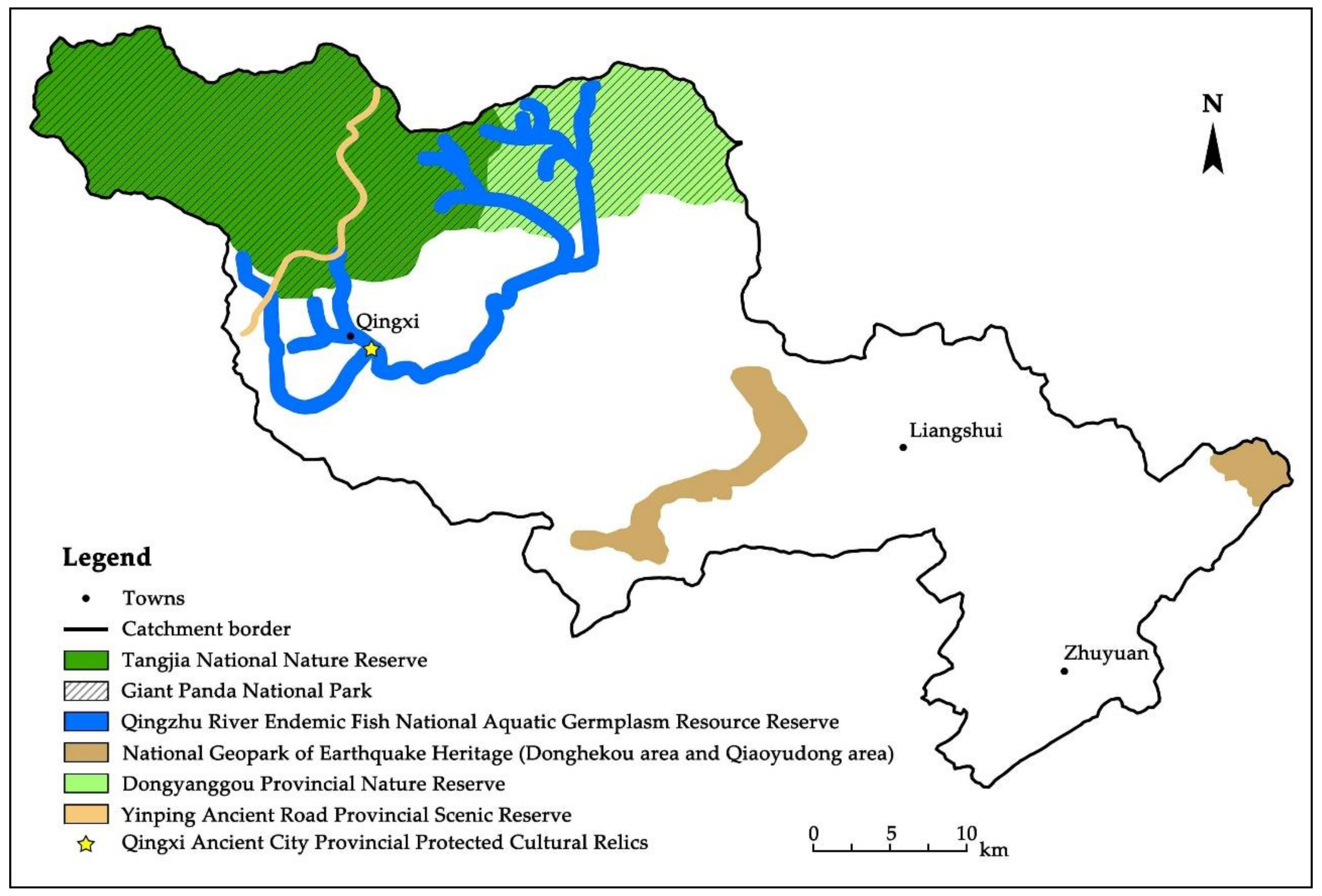
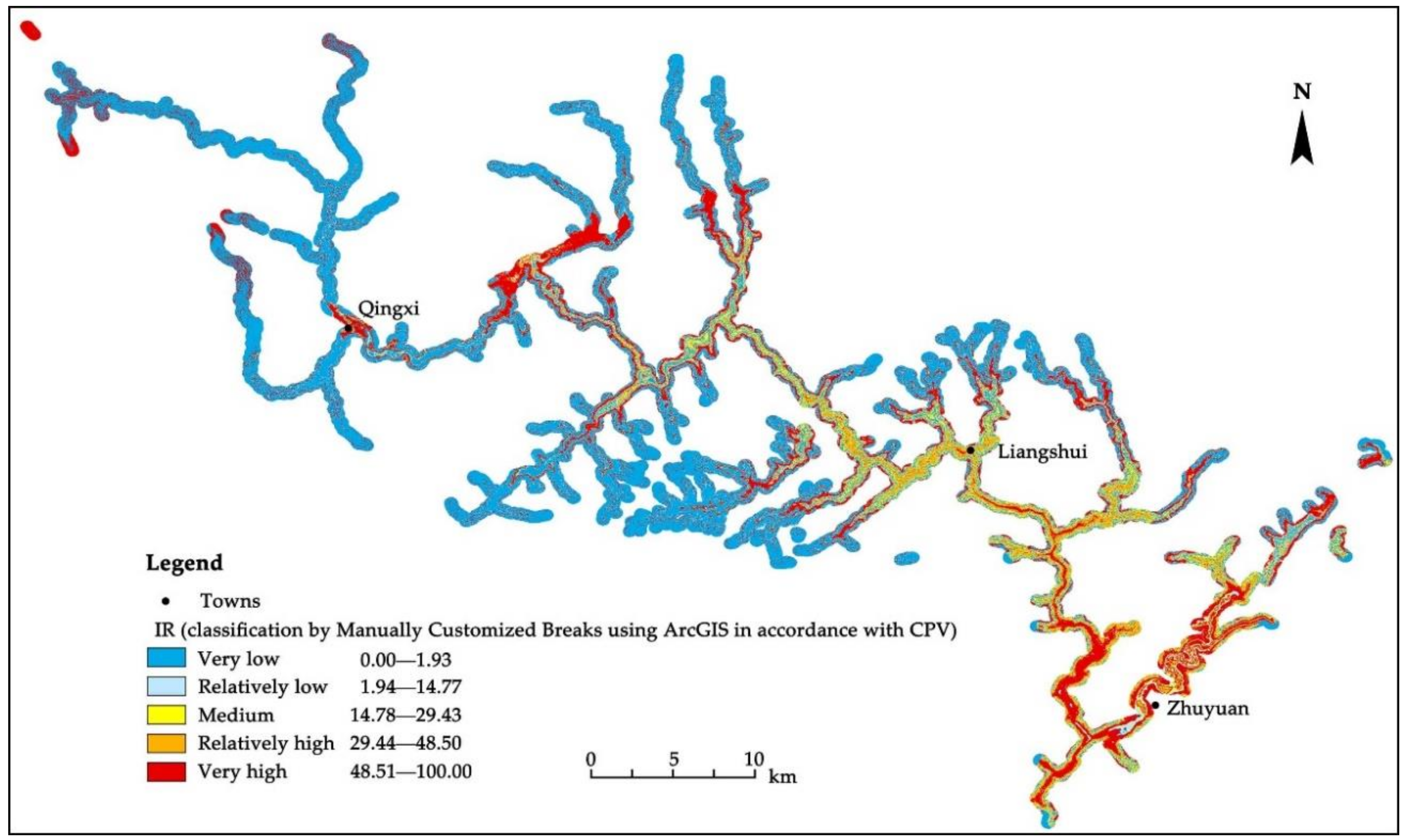
| Species Name | Endemism | Protection Class | Note | Distribution Sub-Catchments |
|---|---|---|---|---|
| Schizothorax prenanti | R | 1, 2, 3, 10 | ||
| Schizothorax (Racoma) davidi | Provincial | 10 | ||
| Schizothorax siensis | R | 1, 2, 3, 10 | ||
| Schistura fasciolata | R | 3, 8, 9, 10, 13, 20 | ||
| Paracobitis potanini | R | 1–10, 12, 13, 14, 19, 20, 21, 23 | ||
| Sinogastromyzon szechuanensis | R | Provincial | 1–10, 12, 13, 14, 19, 20, 21, 23 | |
| Euchiloglanis kishinouyei | R | 1–11, 13, 14, 16, 17, 20, 21, 23 | ||
| Edavidi | R | Provincial | 1–11, 13, 14, 16, 17, 20, 21, 23 | |
| Andrias davidianus (Giant salamander) | R | National II | IUCN: EN | 1–14, 16–24 |
| Tylototriton wenxianensis (Wenxian wart newt) | R | National II | IUCN: VN | 1–6 |
References
- Mukul, S.A.; Rashid, A.Z.M.M. Protected Areas: Policies, Management and Future Directions; Nova Science Publishers: New York, NY, USA, 2017. [Google Scholar]
- Venter, O.; Fuller, R.A.; Segan, D.B.; Carwardine, J.; Brooks, T.; Butchart, S.H.M.; Di Marco, M.; Iwamura, T.; Joseph, L.; O’Grady, D.; et al. Targeting Global Protected Area Expansion for Imperiled Biodiversity. PLoS Biol. 2014, 12, e1001891. [Google Scholar] [CrossRef]
- Mukul, S.A.; Sohel, M.S.I.; Herbohn, J.; Inostroza, L.; König, H. Integrating ecosystem services supply potential from future land-use scenarios in protected area management: A Bangladesh case study. Ecosyst. Serv. 2017, 26, 355–364. [Google Scholar] [CrossRef]
- Primack, R.B. Essentials of Conservation Biology, 5th ed.; Sinauer Associates, Inc.: Sunderland, UK, 2010. [Google Scholar]
- Dudley, N.; Shadie, P.; Stolton, S. Guidelines for Applying Protected Area Management Categories; IUCN: Gland, Switzerland, 2013. [Google Scholar]
- Fernandes, M.D.L.; Quintela, A.; Alves, F.L. Identifying conservation priority areas to inform maritime spatial planning: A new approach. Sci. Total Environ. 2018, 639, 1088–1098. [Google Scholar] [CrossRef] [PubMed]
- Bax, V.; Francesconi, W. Conservation gaps and priorities in the Tropical Andes biodiversity hotspot: Implications for the expansion of protected areas. J. Environ. Manag. 2019, 232, 387–396. [Google Scholar] [CrossRef] [PubMed]
- Walsh, A.; Sullivan, C.A.; Waldren, S.; Finn, J.A. Development of a scoring method to identify important areas of plant diversity in Ireland. J. Nat. Conserv. 2019, 47, 1–11. [Google Scholar] [CrossRef]
- Pikesley, S.K.; Godley, B.J.; Latham, H.; Richardson, P.B.; Robson, L.M.; Solandt, J.L.; Trundle, C.; Wood, C.; Witt, M.J. Pink sea fans (Eunicella verrucosa) as indicators of the spatial efficacy of Marine Protected Areas in southwest UK coastal waters. Mar. Policy 2016, 64, 38–45. [Google Scholar] [CrossRef]
- Zhang, Z.M.; Sherman, R.; Yang, Z.J.; Wu, R.D.; Wang, W.L.; Yin, M.; Yang, G.H.; Ou, X.K. Integrating a participatory process with a GIS-based multi-criteria decision analysis for protected area zoning in China. J. Nat. Conserv. 2013, 21, 225–240. [Google Scholar] [CrossRef]
- Habtemariam, B.T.; Fang, Q. Zoning for a multiple-use marine protected area using spatial multi-criteria analysis: The case of the Sheik Seid Marine National Park in Eritrea. Mar. Policy 2016, 63, 135–143. [Google Scholar] [CrossRef]
- Bottrill, M.C.; Joseph, L.N.; Carwardine, J.; Bode, M.; Cook, C.; Game, E.; Grantham, H.; Kark, S.; Linke, S.; McDonald-Madden, E.; et al. Finite conservation funds mean triage is unavoidable. Trends Ecol. Evol. 2009, 24, 183–184. [Google Scholar] [CrossRef]
- Hanson, J.O.; Rhodes, J.R.; Butchart, S.H.M.; Buchanan, G.M.; Rondinini, C.; Ficetola, G.F.; Fuller, R.A. Global conservation of species’ niches. Nature 2020, 580, 232–234. [Google Scholar] [CrossRef]
- Yang, R.; Cao, Y.; Hou, S.Y.; Peng, Q.Y.; Wang, X.S.; Wang, F.Y.; Tseng, T.; Yu, L.; Carver, S.; Convery, I.; et al. Cost-effective priorities for the expansion of global terrestrial protected areas: Setting post-2020 global and national targets. Sci. Adv. 2020, 6, 1–8. [Google Scholar] [CrossRef] [PubMed]
- Lv, Z.; Yang, J.; Wielstra, B.; Wei, J.; Xu, F.; Si, Y. Prioritizing green spaces for biodiversity conservation in Beijing based on habitat network connectivity. Sustainability 2019, 11, 2042. [Google Scholar] [CrossRef]
- Asaad, I.; Lundquist, C.J.; Erdmann, M.V.; Costello, M.J. Delineating priority areas for marine biodiversity conservation in the Coral Triangle. Biol. Conserv. 2018, 222, 198–211. [Google Scholar] [CrossRef]
- Moradi, S.; Ilanloo, S.S.; Kafash, A.; Yousefi, M. Identifying high-priority conservation areas for avian biodiversity using species distribution modeling. Ecol. Indic. 2019, 97, 159–164. [Google Scholar] [CrossRef]
- Pouget, M.; Baumel, A.; Diadema, K.; Medail, F. Conservation unit allows assessing vulnerability and setting conservation priorities for a Mediterranean endemic plant within the context of extreme urbanization. Biodivers. Conserv. 2017, 26, 293–307. [Google Scholar] [CrossRef]
- Carrizo, S.F.; Lengyel, S.; Kapusi, F.; Szabolcs, M.; Kasperidus, H.D.; Scholz, M.; Markovic, D.; Freyhof, J.; Cid, N.; Cardoso, A.C.; et al. Critical catchments for freshwater biodiversity conservation in Europe: Identification, prioritisation and gap analysis. J. Appl. Ecol. 2017, 54, 1209–1218. [Google Scholar] [CrossRef]
- Holland, R.A.; Darwall, W.R.T.; Smith, K.G. Conservation priorities for freshwater biodiversity: The Key Biodiversity Area approach refined and tested for continental Africa. Biol. Conserv. 2012, 148, 167–179. [Google Scholar] [CrossRef]
- Burnett, K.; Reeves, G.; Miller, D.; Clarke, S.; Christiansen, K.; Vance-Borland, K. Aquatic protected areas: What works best and how do we know? In Proceedings of the World Congress on Aquatic Protected Areas, Cairns, Australia, 14–17 August 2002; Beumer, J.P., Grant, A., Smith, D.C., Eds.; Australian Society for Fish Biology: North Beach, WA, Australia, 2003. [Google Scholar]
- Nel, J.L.; Roux, D.J.; Maree, G.; Kleynhans, C.J.; Moolman, J.; Reyers, B.; Rouget, M.; Cowling, R.M. Rivers in peril inside and outside protected areas: A systematic approach to conservation assessment of river ecosystems. Divers. Distrib. 2007, 13, 341–352. [Google Scholar] [CrossRef]
- Grill, G.; Lehner, B.; Thieme, M.; Geenen, B.; Tickner, D.; Antonelli, F.; Babu, S.; Borrelli, P.; Cheng, L.; Crochetiere, H.; et al. Mapping the world’s free-flowing rivers. Nature 2019, 569, 215–221. [Google Scholar] [CrossRef]
- Dolezsai, A.; Sály, P.; Takács, P.; Hermoso, V.; Erős, T. Restricted by borders: Trade-offs in transboundary conservation planning for large river systems. Biodivers. Conserv. 2015, 24, 1403–1421. [Google Scholar] [CrossRef]
- Hua, Y.; Cui, B.; He, W.; Cai, Y. Identifying potential restoration areas of freshwater wetlands in a river delta. Ecol. Indic. 2016, 71, 438–448. [Google Scholar] [CrossRef]
- Chen, L.; Fan, M.; Wang, Q. Spatial priority conservation areas for vegetation habitat across the Upper Reaches of Min River located in Sichuan Province, China. Glob. Ecol. Conserv. 2019, 17, 1–13. [Google Scholar] [CrossRef]
- Funk, A.; Martínez-López, J.; Borgwardt, F.; Trauner, D.; Bagstad, K.J.; Balbi, S.; Magrach, A.; Villa, F.; Hein, T. Identification of conservation and restoration priority areas in the Danube River based on the multi-functionality of river-floodplain systems. Sci. Total Environ. 2019, 654, 763–777. [Google Scholar] [CrossRef] [PubMed]
- Zhang, L.; Ouyang, Z.Y.; Xu, W.H. Theory, work frame and hot issues of systematic conservation planning. Acta Ecol. Sin. 2015, 35, 1284–1295. [Google Scholar]
- Hu, J.C.; Deng, H.K.; Zhang, J.; Li, M.F.; Li, Y.H.; Li, C.; Xu, X.; Ou, W.F.; Chen, L.M.; Qin, Z.S.; et al. A Comprehensive Scientific Investigation Report on Tangjiahe Nature Reserve in Sichuan Province, China; Sichuan Science and Technology Press: Chengdu, China, 2005. [Google Scholar]
- Codification Committee of Guangyuan City Local Chronicles. Guangyuan County Annals; Sichuan Cishu Publishing House: Chengdu, China, 1994. [Google Scholar]
- Leopold, A. Sand County Almanac and Sketches Here and There; Oxford University Press: New York, NY, USA, 1949. [Google Scholar]
- Karr, J.R.; Dudley, I.J. Ecological perspective on water quality goals. Environ. Manag. 1981, 5, 55–68. [Google Scholar] [CrossRef]
- Miller, P.; Ehnes, J.M. Can Canadian approaches to sustainable forest management maintain ecological integrity? In Ecological Integrity: Integrating Environment, Conservation, and Health; Pimentel, D., Westra, L., Noss, R.F., Eds.; Island Press: Washington, DC, USA, 2000; Chapter 9; pp. 157–176. [Google Scholar]
- UNESCO. Operational Guidelines for the Implementation of the World Heritage Convention; UNESCO World Heritage Centre: Paris, France, 2019. [Google Scholar]
- He, S.Y.; Su, Y. Authenticity, integrity, connectivity and coordination-conceptual analysis and practical significance for the establishment of the National Park system. Environ. Prot. 2019, 47, 28–34. [Google Scholar]
- Clewell, A.F. Restoring for natural authenticity. Ecol. Restor. 2000, 18, 216–217. [Google Scholar] [CrossRef][Green Version]
- IUCN; WCMC. Guidelines for Protected Area Management Categories; IUCN: Gland, Switzerland, 1994. [Google Scholar]
- Parrish, J.D.; Braun, D.P.; Unnasch, R.S. Are we conserving what we say we are? Measuring ecological integrity within protected areas. BioScience 2003, 53, 851–860. [Google Scholar] [CrossRef]
- Laurich, B.; Drake, C.; Gorman, O.T.; Irvine, C.; MacLaurin, J.; Chartrand, C.; Hebert, C.E. Ecosystem change and population declines in gulls: Shifting baseline considerations for assessing ecological integrity of protected areas. J. Great Lakes Res. 2019, 45, 764–775. [Google Scholar] [CrossRef]
- Faber-Langendoen, D.; Lemly, J.; Nichols, W.; Rocchio, J.; Walz, K.; Smyth, R. Development and evaluation of NatureServe’s multi-metric ecological integrity assessment method for wetland ecosystems. Ecol. Indic. 2019, 104, 764–775. [Google Scholar] [CrossRef]
- Dudley, N. Authenticity in Nature: Making Choices about the Naturalness of Ecosystems; Routledge: London, UK; New York, NY, USA, 2012. [Google Scholar]
- Fraser, R.H.; Olthof, I.; Pouliot, D. Monitoring land cover change and ecological integrity in Canada’s national parks. Remote Sens. Environ. 2009, 113, 1397–1409. [Google Scholar] [CrossRef]
- Yu, H.; Zhong, L.S. Discussion on the selection criteria of national parks in China based on international experience. Acta Ecol. Sin. 2019, 39, 1309–1317. [Google Scholar]
- Wang, Y. Practice and innovation for overarching institution design of China’s national park. Biodivers. Sci. 2018, 25, 1037–1039. [Google Scholar] [CrossRef]
- Secretariat of the Convention on Biological Diversity (CBD). CBD GUIDELINES: The Ecosystem Approach; The Secretariat of the Convention on Biological Diversity: Montreal, QC, Canada, 2004.
- Gill, S. The Ecosystem Approach: Five Steps to Implementation (from IUCN Website). Available online: https://www.iucn.org/content/ecosystem-approach-five-steps-implementation-0 (accessed on 16 June 2020).
- Browman, H.I.; Stergiou, K.I. Marine Protected Areas as a central element of ecosystem-based management: Defining their location, size and number. Mar. Ecol. Prog. Ser. 2004, 274, 271–272. [Google Scholar]
- Peng, J.; Wang, A.; Luo, L.W.; Liu, Y.X.; Li, H.L.; Hu, Y.N.; Meersmans, J.; Wu, J.S. Spatial identification of conservation priority areas for urban ecological land: An approach based on water ecosystem services. Land Degrad. Dev. 2019, 30, 683–694. [Google Scholar] [CrossRef]
- Fan, M.; Shibata, H.; Wang, Q. Optimal conservation planning of multiple hydrological ecosystem services under land use and climate changes in Teshio river watershed, northernmost of Japan. Ecol. Indic. 2016, 62, 1–13. [Google Scholar] [CrossRef]
- Xu, W.H.; Xiao, Y.; Zhang, J.J.; Yang, W.; Zhang, L.; Hull, V.; Wang, Z.; Zheng, H.; Liu, J.G.; Polasky, S.; et al. Strengthening protected areas for biodiversity and ecosystem services in China. Proc. Natl. Acad. Sci. USA 2017, 114, 1601–1606. [Google Scholar] [CrossRef]
- ABOUT THE WSR ACT: Safeguarding the Character of Our Nation’s Unique Rivers. Available online: https://www.rivers.gov/wsr-act.php (accessed on 22 September 2020).
- Brougher, C. The Wild and Scenic Rivers Act (WSRA): Protections, Federal Water Rights, and Development Restrictions (CRS Report for Congress); Congressional Research Service: Washington, DC, USA, 2010; Report Number: R41081.
- Perry, D.M. Reframing the Wild and Scenic Rivers Act for Ecosystem Based Resilience and Adaptation. J. Wilderness Med. 2017, 23, 41–48. [Google Scholar]
- Song, M.M.; Tian, S.; Lu, A.R.; Yin, X.W.; Xu, Z.X. Establishment of evaluation system of an ecosystem integrity in Weihe River. J. Dalian Ocean Univ. 2020, 35, 288–295. [Google Scholar]
- Huang, B.R.; Ouyang, Z.Y.; Zheng, H.; Wang, X.K.; Miao, H. Connotation of ecological integrity and its assessment methods: A review. Chin. J. Appl. Ecol. 2006, 17, 2196–2202. [Google Scholar]
- Allan, J.D.; Castillo, M.M. Stream Ecology: Structure and Function of Running Waters; Springer Science & Business Media: Berlin, Germany, 2007. [Google Scholar]
- Mo, K.; Chen, Q.W.; Chen, C.; Zhang, J.Y.; Wang, L.; Bao, Z.X. Spatiotemporal variation of correlation between vegetation cover and precipitation in an arid mountain-oasis river basin in northwest China. J. Hydrol. 2019, 574, 138–147. [Google Scholar] [CrossRef]
- Barber, C.P.; Cochrane, M.A.; Souza, C.M.; Laurance, W.F. Roads, deforestation, and the mitigating effect of protected areas in the Amazon. Biol. Conserv. 2014, 177, 203–209. [Google Scholar] [CrossRef]
- Januchowski-Hartley, S.; Pearson, R.; Puschendorf, R.; Rayner, T. Fresh waters and fish diversity: Distribution, protection and disturbance in Tropical Australia. PLoS ONE 2011, 6, e25846. [Google Scholar] [CrossRef] [PubMed]
- Hewlett, J.D. Principles of Forest Hydrology; University of Georgia Press: Athens, GA, USA, 1982. [Google Scholar]
- Wei, X.H.; Sun, G. Watershed Ecosystem Processes and Management, 1st ed.; Higher Education Press: Beijing, China, 2009. [Google Scholar]
- Davies, S.P.; Jackson, S.K. The biological condition gradient: A descriptive model for interpreting change in aquatic ecosystems. Ecol. Appl. 2006, 16, 1251–1266. [Google Scholar] [CrossRef]
- Stewart, R.R.; Possingham, H.P. Efficiency, costs and trade-offs in marine reserve system design. Environ. Modeling Assess. 2005, 10, 203–213. [Google Scholar] [CrossRef]
- Global Land Analysis & Discovery (GLAD), Global 2010 Tree Cover (30 m). Available online: https://glad.umd.edu/dataset/global-2010-tree-cover-30-m (accessed on 7 October 2019).
- Sanderson, E.W.; Jaiteh, M.; Levy, M.A.; Redford, K.H.; Wannebo, A.V.; Woolmer, G. The human footprint and the last of the wild: The human footprint is a global map of human influence on the land surface, which suggests that human beings are stewards of nature, whether we like it or not. BioScience 2002, 52, 891–904. [Google Scholar] [CrossRef]
- NASA Socioeconomic Data and Applications Center (SEDAC). A Data Center in NASA’s Earth Observing System Data and Information System (EOSDIS), Last of the Wild, v2. Available online: https://sedac.ciesin.columbia.edu/data/collection/wildareas-v2/methods# (accessed on 6 June 2020).
- Woolmer, G.; Trombulak, S.C.; Ray, J.C.; Doran, P.J.; Anderson, M.G.; Baldwin, R.F.; Morgan, A.; Sanderson, E.W. Rescaling the Human Footprint: A tool for conservation planning at an ecoregional scale. Landsc. Urban Plan. 2008, 87, 42–53. [Google Scholar] [CrossRef]
- Yu, H.; Zhong, L.S.; Zeng, Y.X. Research on identification of potential regions of national parks in China. J. Nat. Resour. 2018, 33, 1766–1780. [Google Scholar]
- Margules, C.R.; Pressey, R.L. Systematic conservation planning. Nature 2000, 405, 243–253. [Google Scholar] [CrossRef]
- Margules, C.R.; Sarkar, S. Systematic Conservation Planning; Cambridge University Press: Cambridgeshire, UK, 2007. [Google Scholar]
- Frederico, R.G.; Zuanon, J.; De Marco, P. Amazon protected areas and its ability to protect stream-dwelling fish fauna. Biol. Conserv. 2018, 219, 12–19. [Google Scholar] [CrossRef]
- Soulé, M.E.; Sanjayan, M.A. Conservation Targets: Do They Help? Science 1998, 279, 2060–2061. [Google Scholar] [PubMed]
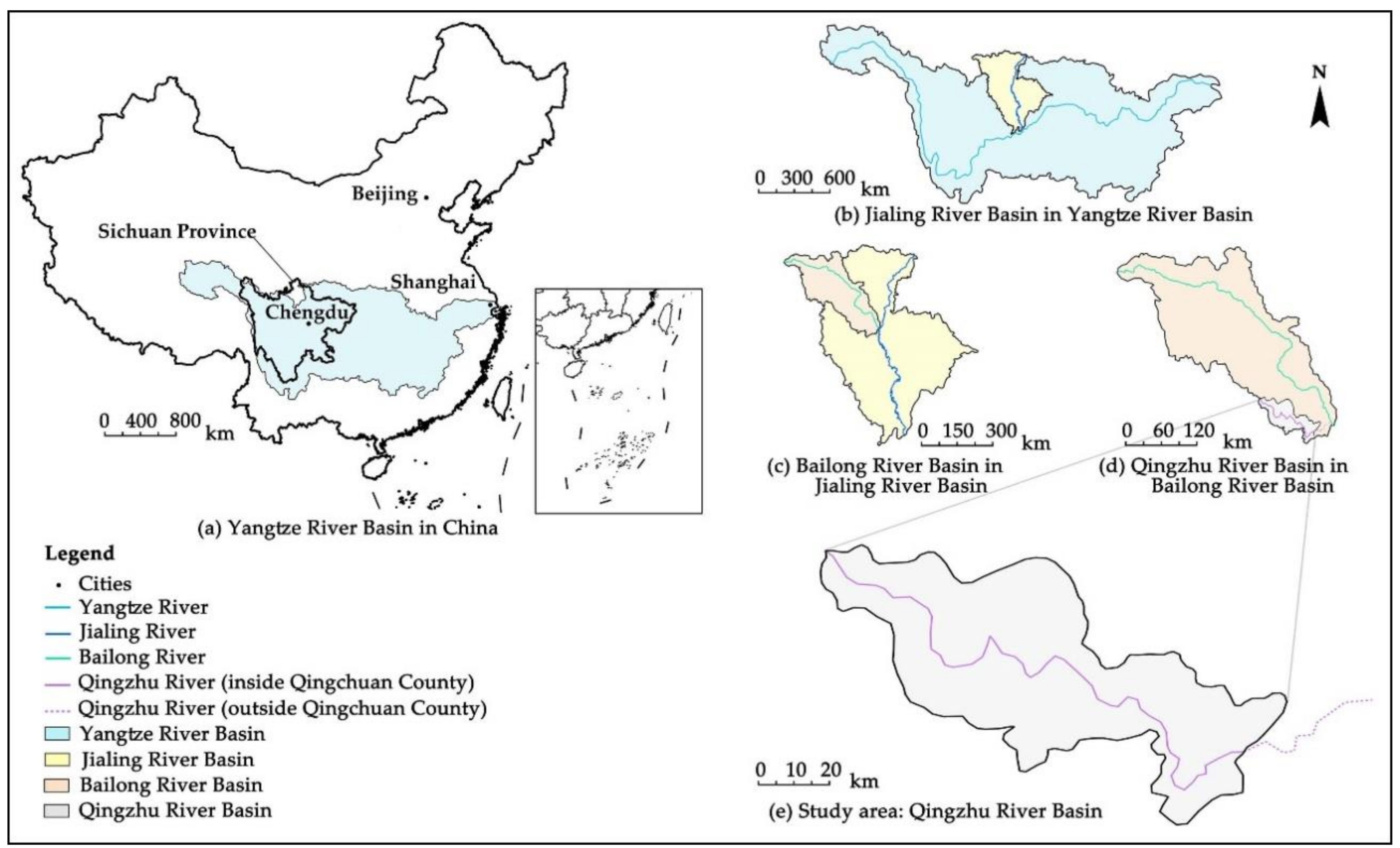
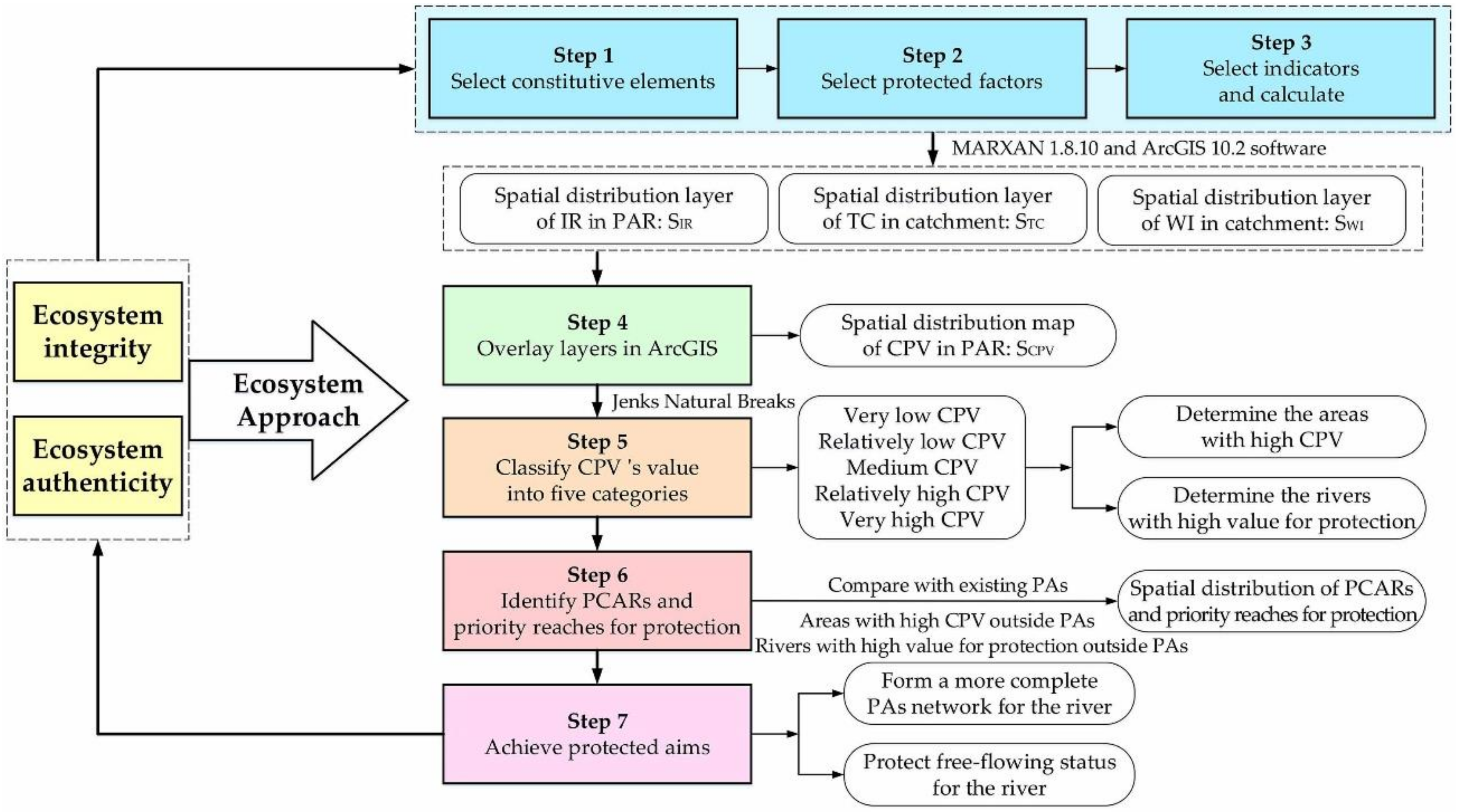
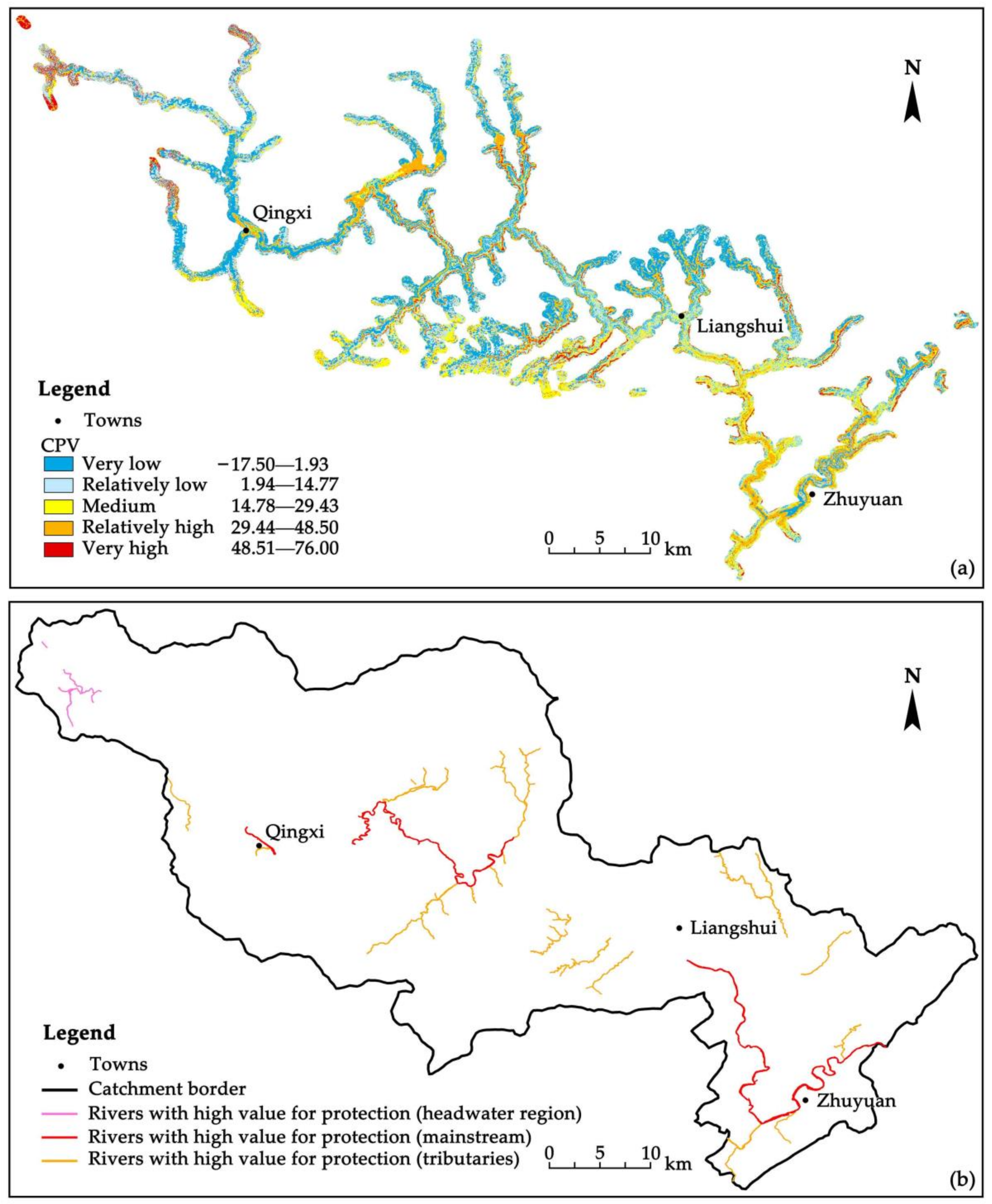
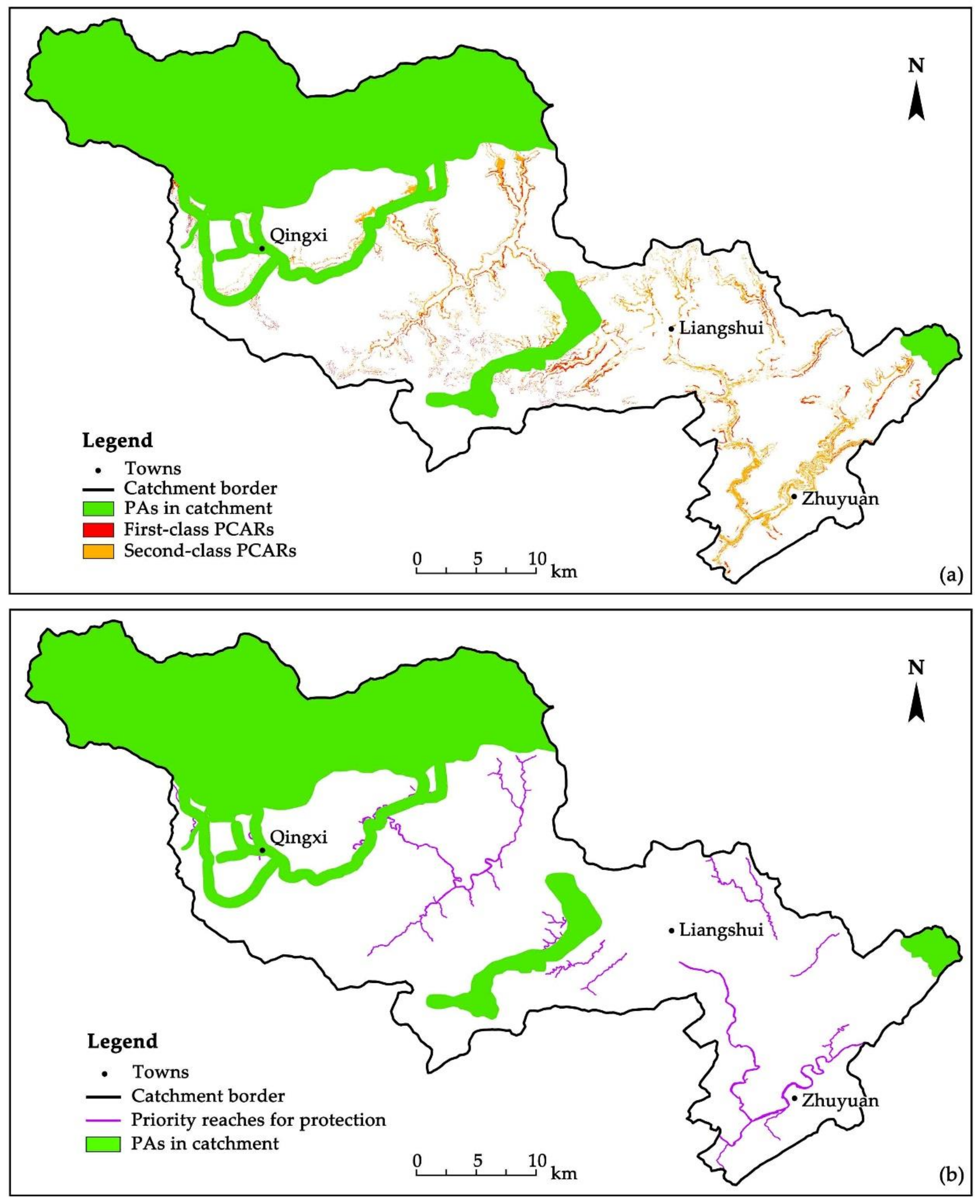
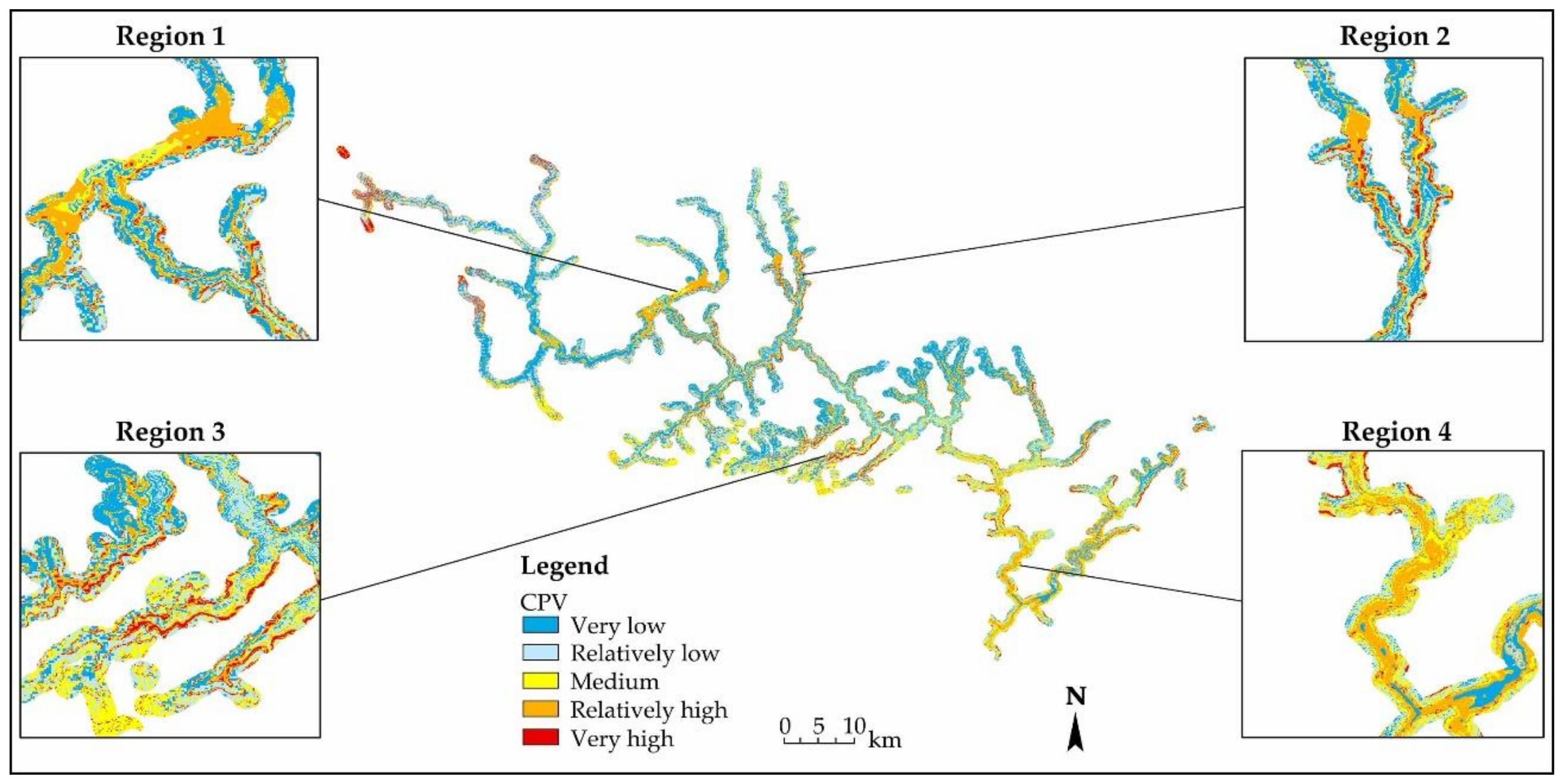
| Category | Name | Data Metrics | Data Resource | Year |
|---|---|---|---|---|
| Physical geography | DEM | 30 m × 30 m resolution | http://www.gscloud.cn | 2009 |
| River distribution | Polygon vector data of .shp format | Qingchuan County Agricultural Promotion Center | 2018 | |
| Land use | 30 m × 30 m resolution; includes six first-class types and 22 s-class types totally | Institute of Geographic Sciences and Natural Resources Research, Chinese Academy of Sciences: http://www.igsnrr.ac.cn/ | 2015 | |
| Tree cover | Global tree cover (except for Antarctica and some Arctic islands); 30 m × 30 m resolution | It is made collaboratively by GLAD, Google, USGS and NASA: https://glad.umd.edu/dataset/global-2010-tree-cover-30-m | 2012 | |
| Species distribution | Including eight freshwater fishes and two amphibian species | Comprehensive Scientific Investigation Report of Tangjiahe Natural Reserve, Sichuan Province; Investigation of Qingzhu River | 2003 | |
| Socio-economic | Road distribution | Including distribution of highways, main roads, secondary roads and railroads | Qingchuan Transport Bureau | 2015 |
| Rural per-capita disposable income | Non-monetary cost to depict conservation cost | Qingchuan County Statistics Yearbook (from Qingchuan Statistics Bureau) | 2017 | |
| Population amount | Number of permanent residents at the end of the year for each township | Qingchuan County Statistics Yearbook (from Qingchuan Statistics Bureau) | 2017 | |
| Population density | Spatial distribution of registered resident of respective counties in the catchment; 1 km × 1 km resolution | Resource and Environment Data Cloud Platform: http://www.resdc.cn | 2015 | |
| nighttime lights | DMSP-OLS nighttime lights time series; 1 km × 1 km resolution | National Oceanic and Atmospheric Administration: www.noaa.gov | 2013 |
| Layers of Human Influence | Classification | Influence Index |
|---|---|---|
| Population density (person/km2) | 0–0.5 | 0 |
| 0.6–1.5 | 1 | |
| 1.6–2.5 | 2 | |
| 2.6–3.5 | 3 | |
| 3.6–4.5 | 4 | |
| 4.6–5.5 | 5 | |
| 5.6–6.5 | 6 | |
| 6.6–7.5 | 7 | |
| 7.6–8.5 | 8 | |
| 8.6–9.5 | 9 | |
| ≥9.5 | 10 | |
| Land use | paddy field | 5 |
| dry land | 3 | |
| forestland | 1 | |
| bush forest | 2 | |
| sparse woodland | 2 | |
| other woodland | 2 | |
| grassland | 2 | |
| canal | 0 | |
| lake | 0 | |
| reservoir | 1 | |
| permanent glacier-snow land | 0 | |
| shoal | 0 | |
| urban land | 10 | |
| rural settlement | 8 | |
| other construction land | 7 | |
| sand | 0 | |
| wetland | 0 | |
| bare land | 0 | |
| bare rock land | 0 | |
| other unused land | 0 | |
| Distance from road (km) | ≤2 | 8 |
| 2–7.5 | 6 | |
| 7.5–15 | 4 | |
| >15 | 0 | |
| Distance from railway (km) | ≤2 | 8 |
| >2 | 0 | |
| Nighttime lights | 0 | 0 |
| 1–38 | 3 | |
| 39–88 | 6 | |
| >88 | 10 | |
| Slope (degree°) | 0–5 | 4 |
| 5–8 | 3 | |
| 8–15 | 2 | |
| 15–25 | 1 | |
| >25 | 0 |
| CPV Value | Categories of CPV | Proportion in PAR Area | |
|---|---|---|---|
| [−17.50, 1.93] | low-value CPV | very low | 29.85% |
| [1.94, 14.77] | relatively low | 29.91% | |
| [14.78, 29.43] | medium-value CPV | medium | 19.71% |
| [29.44, 48.50] | high-value CPV | relatively high | 14.65% |
| [48.51, 76.00] | very high | 5.88% | |
| (a) Results of PCARs | |||
| PCAR Type | Area (km2) | Proportion in PAR Area | |
| first-class PCARs | upper rivers | 1.17 | 0.25% |
| middle rivers | 9.51 | 2.00% | |
| lower rivers | 6.00 | 1.26% | |
| total | 16.68 | 3.51% | |
| second-class PCARs | upper rivers | 3.65 | 0.77% |
| middle rivers | 20.38 | 4.29% | |
| lower rivers | 31.17 | 6.56% | |
| total | 55.20 | 11.62% | |
| all PCARs | total | 71.88 | 15.13% |
| (b) Results of priority reaches for protection | |||
| Priority Reaches for Protection Fall within Mainstream | Length (km) | Proportion in Mainstream within Qingchuan County | |
| upper mainstream | 5.32 | 3.45% | |
| middle mainstream | 23.60 | 15.33% | |
| lower mainstream | 47.05 | 30.55% | |
| total | 75.97 | 49.33% | |
Publisher’s Note: MDPI stays neutral with regard to jurisdictional claims in published maps and institutional affiliations. |
© 2020 by the authors. Licensee MDPI, Basel, Switzerland. This article is an open access article distributed under the terms and conditions of the Creative Commons Attribution (CC BY) license (http://creativecommons.org/licenses/by/4.0/).
Share and Cite
Li, P.; Zhang, Y.; Lu, W.; Zhao, M.; Zhu, M. Identification of Priority Conservation Areas for Protected Rivers Based on Ecosystem Integrity and Authenticity: A Case Study of the Qingzhu River, Southwest China. Sustainability 2021, 13, 323. https://doi.org/10.3390/su13010323
Li P, Zhang Y, Lu W, Zhao M, Zhu M. Identification of Priority Conservation Areas for Protected Rivers Based on Ecosystem Integrity and Authenticity: A Case Study of the Qingzhu River, Southwest China. Sustainability. 2021; 13(1):323. https://doi.org/10.3390/su13010323
Chicago/Turabian StyleLi, Peng, Yuxiao Zhang, Weikun Lu, Min Zhao, and Meng Zhu. 2021. "Identification of Priority Conservation Areas for Protected Rivers Based on Ecosystem Integrity and Authenticity: A Case Study of the Qingzhu River, Southwest China" Sustainability 13, no. 1: 323. https://doi.org/10.3390/su13010323
APA StyleLi, P., Zhang, Y., Lu, W., Zhao, M., & Zhu, M. (2021). Identification of Priority Conservation Areas for Protected Rivers Based on Ecosystem Integrity and Authenticity: A Case Study of the Qingzhu River, Southwest China. Sustainability, 13(1), 323. https://doi.org/10.3390/su13010323





